|
Shanties disappear - new apartments built in Colombo:
Moving into better living conditions
By Dhaneshi Yatawara
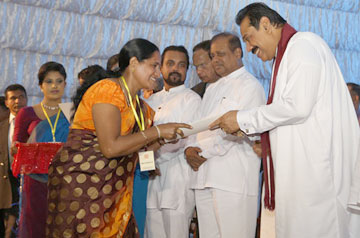 |
|
President Mahinda
Rajapaksa handing over houses to occupants of Lakmuthu Sevana
Housing Scheme |
Urbanisation has hit the townships in Sri Lanka on a large scale
particularly in the city of Colombo. Families living in dire situations
in temporary shelters which they called home, made out of chip board,
metal sheets and wooden planks - these 'houses' hardly had the basic
requirements for decent living. no toilets, clean drinking water not
even a clean place to sleep at the end of a long tiring day. This was
their lot for many decades, thanks to the urbanisation program, they
will now live in comfortable homes.
According to statistics with the Urban Development Authority, nearly
53% of Colombo's population lives in under-served communities such as
shanties, shabbily maintained apartments and line-houses.
There are shanties or squatters, slums, dilapidated labour quarter
sites, service schemes and low cost flats clustered in different parts
of Colombo metro. Shanties or squatters could be considered as the worst
of its kind.
Within Colombo, these communities live on nearly 900 acres of land.
According to the UDA the number of households to date in these
communities is more than 68,000 with a population of over 300,000. They
are occupying only 10 percent of the total area of Colombo. The lands
they live in are mostly in the northern and eastern parts of Colombo
such as Modera, Borella and Dematagoda which are with high commercial
value.
New apartments
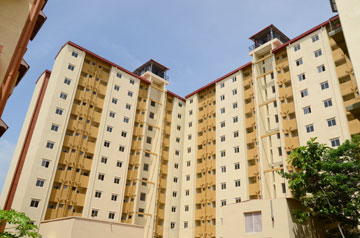 |
|
Sirisanda Sewana housing
project |
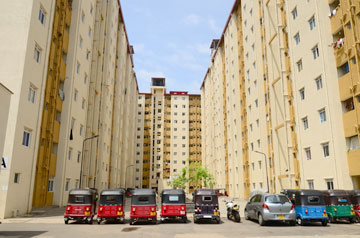 |
|
Sirisara Uyana Housing
Project in Wanathamulla |
To release these commercially viable lands 15,000 housing units are
under various stages of construction in the Colombo area, as projects of
the Urban Development Authority.
The first 500-unit project that was completed and handed over over to
the slum and shanty dwellers in November 2013 - was Mihindusenpura in
Dematagoda.
The latest housing project was opened on October 7 at Mayura Place in
Wellawatte by President Mahinda Rajapaksa.
This project with 118 housing units was named as Lakmuthu Sevana.
UDA continuing the project to address the housing needs of these
backward communities have completed two more apartments to provide
houses for these low income families.
These two housing projects will be handed over to the public by
President Mahinda Rajapaksa within the course of this month - one in
Bloemendhal road which will be handed over to residents on October 17
and the other in Wanathamulla in Borella on October 27. . Once known
island wide for its dire situations these two areas have now transformed
in to unbelievably liveable places with so much of fresh air to breath.
The 'Siridsandasevana' housing scheme which is a walk up apartment
provide houses for 366 families who were living in shanties for a long
time in and around Bloemendhal area.
The 'Sirisara Uyana' and the 'Methsara Uyana' in Wanathamulla will
house over 1140 families who were living in temporary shelters around
Wanathamulla and parts of Borella.
The apartments comprise modern houses with ample space, rooms,
balcony and proper sanitary facilities as well as safe drinking water,
electricity. It is a life these people who were working hard to earn a
meager income were dreaming since the day they settled down in Colombo.
People living in these under-served communities comprise almost all
the labour force that make the Colombo city function. They are an
important part and parcel of the society. "Many of these people work in
the harbour, Railway Department and Municipal Council forming their
entire labour force. They are playing a pivotal role in the proper
functioning of the Colombo city," said Head of the Project Planning Unit
of the Urban Regeneration project under the UDA, E.A.C. Priyashantha.
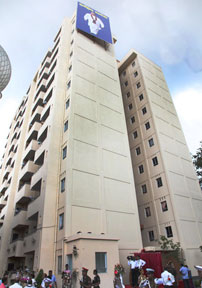 |
| The Lakmuthu
Sevana Housing Scheme in Bloemandhal road |
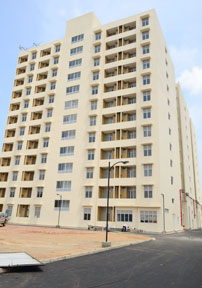 |
| Methsara Uyana
Housing Scheme in Wanathamulla, Borella |
Thus they need to be housed within Colombo and they need to be given
the due recognition.
"Many past Governments attempted to bring a solution to this problem.
Though the UDA had no involvement in those initiatives we can see that
the difficulty in getting lands to rehouse the shanty dwellers and
inadequate funding made those projects collapse," said Priyashantha.
Change
Yet this time under the guidance of the Secretary to the Ministry of
Defence and Urban Development, Gotabaya Rajapaksa, the UDA launched the
program, coordinating with other ministries to liberate their lands to
rehouse people and issuing a Rs. 10 billion debenture. When rehousing
had to be done there was a method to get the necessary lands and money
was there to make it a viable project, according to Priyashantha.
The land liberation program is not only confined to Colombo. The UDA
is spearheading projects in key cities of the country like Kandy and
Kurunegala.
The intention is to elevate the cities to commercial hubs along with
proper planning, according to Priyashantha.
Today the UDA has not only built proper housing for these people but
have taken steps to lay a support line for these shanty dwellers to get
used to their new surroundings.
The duty of the project coordination unit of the Urban Regeneration
project is to analyse the true situation these shanty people live in and
coordinate their requirements to the project management. "All their
rehousing locations were in close proximity to their original homes
without taking them away from the area they were living in for many
years," said Prasad Ranaweera, the Head of the Project Coordination
Unit.A team of UDA officials from this unit, which also includes
graduates in Sociology, have visited every house of these under-served
communities."Under the direction of the Secretary of the Ministry of
Defence and Urban Development, Gotabaya Rajapaksa, the UDA first
selected the 40,000 shanty dwellers living under the worst conditions
among the under-served communities," said Ranaweera.
Vacate
Such communities who were living in Aluthmawatha, Colombage Mawatha,
Cyril C. Perera Mawatha, Wanathamulla in Borella were areas where they
could easily vacate the land.
"The re-housing project is now located in the closest proximity to
their original houses and today back in their original 'watta' only few
families remain - mainly due to unsettled legal disputes within their
families and financial problems. To those with financial problems we are
coordinating with well-wishers to get support to settle payments for the
new houses," said Ranaweera.
With regard to protests by a few communities initially, Ranaweera
said after the Mihindusenpura rehousing project was completed in
Dematagoda, people of other shanty areas gave their consent.
"People said that they will relocate if they are given houses like
those at Mihindusenpura. And as for the UDA, we were planning similar
projects for these people. We were planning to provide a much better
living standard for these people and they accepted it at the end without
any protest," he said.
Training the people to use the facilities that were made available
for them in the new apartments was a responsibility of the unit
Ranaweera headed. From dumping garbage systematically to organising
community events, the officials of the unit got involved.
They were there to ensure that the people would happily in their new
homes and surroundings. And this will continue in their future
endeavours too.
The challenge lies in the future. More people settling down in cities
and urban areas is not an isolated event but a global phenomena.
According to UN-HABITAT half of the global population live in cities and
it is predicted that within a decade or two nearly 60% of the world
population, that is around five billion people will become urban
dwellers. Sri Lanka will be no exception. The next big challenge for the
authorities and urban planners is to face this and ensure the smooth
functioning of cities! |

